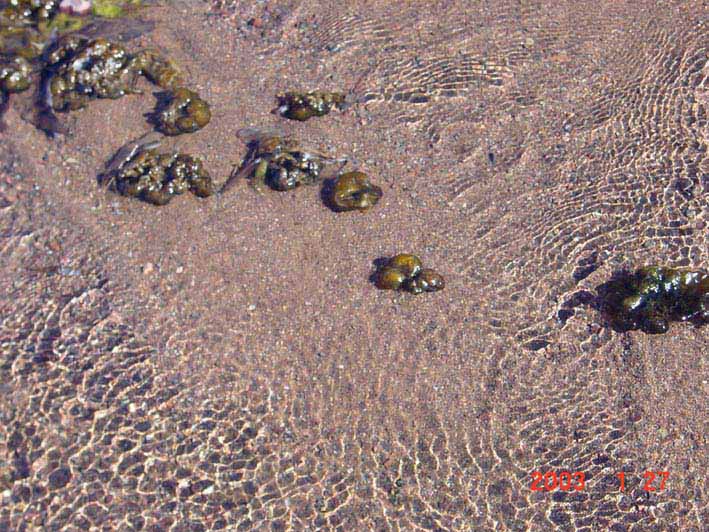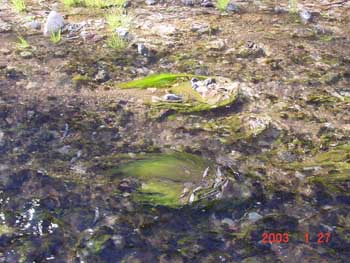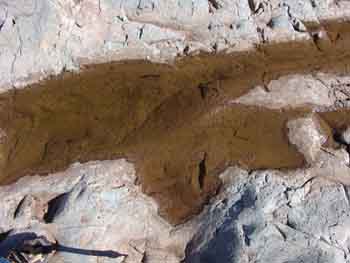
Algal bloom in the High Tank a few days after floodwaters had filled it to the brim, October 2000.
Algae: creators of complex life on earth
The term "algae" refers to a group of organisms that have no comprehensive taxonomic connections -- some belong in the Plant Kingdom, others in that of "Protists" (a recent and questionable classification identifying those eukaryotes -- see below -- lacking complex cell differentiation), and others are most closely linked to the Bacteria. This indicates that the categories used are shaky, that the group does not share a single evolutionary history. They do however (mostly) share a number of features that make somewhat convenient their common classification: very simple structure (with no vascular tissues), unprotected reproductive organs, photosynthesis using sunlight (with the use of various kinds of clorophyll), and most of them are eukaryotes (their cells contain membrane-bound nuclei as well as organelles). But for each of these features exceptions occur: some sea kelps are structurally rather complex; some red algae have protected reproductive organs; some algae lack clorophyll; and some are prokaryotes (lack nuclei), e.g. the cyanobacteria or blue-green algae. See Introduction to Algae, by Derek W. Keats.
Algae are identified in the fossil record at an age of more than 3 Billion years, and Blue-green algae (the Cyanobacteria, photosynthetic protists) are the oldest known living organisms containing clorophyll, which produces nutrients from light and generates oxygen as a byproduct.The evidence thus is that they invented photosynthesis, what Lynn Margulis and Dorion Sagan call "the most important single metabolic innovation in the history of life on the planet" (Microcosmos, NY, 1986: Summit Books, p. 78). Through this process, the Cyanobacteria played a decisive role in building free oxygen in the early Earth, crucial to the development of more complex and active creatures. Today, they continue to produce much of the world's oxygen.
Cyanobacteria can change remarkably in appearance, depending on the environmental conditions. "Blue-green algae are common in soil, in both salt and fresh water, and can grow over a wide range of temperatures. They have been found to form mats in Antarctic lakes under several meters of ice and are responsible for the beautiful colors of the hot springs at Yellowstone and elsewhere. Cyanobacteria can also occur as symbionts of protozoans, diatoms and lichen-forming fungi, and vascular plants. Some blue-greens can fix nitrogen as well as photosynthesize, allowing them to grow with only light, water, a few minerals, and the nitrogen and carbon dioxide in the atmosphere." (National Museum of Natural History, Smithsonian, The Algae)
Algae occur almost everywhere on earth, provided water is present at some time. Where water is substantial and continuously present, algae will be there, from the hot springs of Yellowstone Park to snowfields to saline lakes and the sea (including sea ice). There are Benthic algae (living at the bottom of water bodies), Phytoplankton (microscopic, water-drifting algae), Hypolithic algae that survive in very dry deserts (beneath protective quartz rocks that transmit the sunlight necessary for photosynthesis while conserving precious moisture from dessicating processes -- see further below), air-drifting algae, and algae that live symbiotically with other organisms (for example, with fungi to form lichens). There are Green algae, the most diverse with more than 7,000 species occupying a variety of habitats. Most are aquatic, but some live on trees, in soils, or in symbiosis in lichens. They have two kinds of clorophylls, store starch, and most have firm cell walls. Golden algae are unicellular organisms containing clorophylls that are masked by a carotenoid pigment. They are close to the Brown algae, an almost entirely marine group which includes the giant kelps. Dinoflagellates are free-swimming protists that contain clorophylls yet also share features linking them to animals. Their population blooms produce the "red tides", and some produce neurotoxins that may find their way up the food chain to humans (e.g., paralytic shellfish poisoning). Most are marine, but there are many freshwater species, some of which are found in snow. The Red algae are mostly marine, but a few are found in freshwater. Most are multicellular and grow attached to rocks or other algae.
Our High Tank produces substantial algal blooms whenever it fills with water. Here, below, is a view from January 2005, showing a very active process of oxygen-production. Click on this image for a close-up view.

Our Hypolithic Algae
First, thanks to the work of Saguaro Juniper Associate Nancy Ferguson, we are now exploring the Hypolithic Algae alluded to in the paragraph above. These have been found by researchers in places as remote from one another as the Gobi and Mohave Deserts, thriving beneath translucent quartzite pebbles on desert pavements. Workers in the Mohave Desert have identified 5 new groups of Cyanobacteria (blue-green "algae") living under small translucent pebbles up to 25 mm thick. The pebbles provide a microclimate with enough moisture and light (about .08% of full sunlight at noon) to enable efficient photosynthesis, and enough protection to survive the very high temperatures of a desert summer. (Schlesinger, William, et al, 2003, in Ecology Vol. 84, No. 12, pp. 3222-31)
For an example in our area, see the desert pavement below, on a terrace above Lower Hot Springs Canyon, photographed in late May 2004:

 The quartz pebble is of course the right-hand member of the central pair in the photo above.
The quartz pebble is of course the right-hand member of the central pair in the photo above.
In the photo at the left, the quartz rock of this pair has been turned over, revealing the chlorophyll color attesting to the life underneath. Click on this image to enlarge it. Mohave Desert researcher William Schlesinger (cited above) suggests that the quartz pebbles "confer a modest greenhouse effect that may be important for photosynthetic activity during cool, wet, wintertime periods", while protecting the organisms from the dessicating environment of other seasons. The Mohave cyanobacteria were able to withstand temperatures of more than 90 degrees Centigrade in laboratory conditions, and Schlesinger concludes that "Life on land may have first appeared in such specialized habitats, which modified the otherwise harsh conditions on the primitive Earth".
Here are two from another location on our lands. So far we have found considerable numbers of these hypolithic habitats along our Quiburis-formation terraces, where the pavements have a strong clayey quality and quite a few quartzite pebbles lying on the surface. We also find them on Cascabel Formation pavements where there are numerous quartz outcrops. According to Schlesinger et al., the thickest quartz pebbles harboring cyanobacteria life forms in the Mohave Desert were 25 mm across. Click on this image to enlarge it.
The ancestral forms of Cyanobacteria generated the earliest (3.5 Billion years ago) macroscopic (and thus communitarian) fossils, the stromatolites, some contemporary forms of which are still found living along the northwest coast of Australia.
Aside from these Hypolithic forms of "Algae" we have found in Saguaro Juniper lands, what we can mainly provide at this time in the way of information is some images of the various "Algae-like" aquatic growths we have seen in our portion of southeastern Arizona. But see also our page on Lichens -- life forms of great beauty and variety in our lands, in which Algae play an indispensible role.
Our Aquatic Algae
At the left, below, an image taken by video camera in June of 1993 as Hot Springs Canyon waters were receding above the Yellow Cliffs (and toward the viewer); here the residue of algae looks orange; at the right, a better-resolution image taken in April of 2003 at roughly the same location shows a mixture of brownish polyps and green algae. Click on each image for an enlargement.
 ..
..
In January of 2003, the brown polyps were particularly prominent in the flowing waters of about a quarter-mile further upstream. Click on the image for a polyp close-up.

Below, left: Green algae in strong-flowing Hot Springs Canyon waters near the Muleshoe Reserve boundary, January 2003. Right: a mat of green algae in still-damp soil some yards below a barely-flowing Sierra Blanca Spring, February 2004.
 ..
.. 
In January 2005, Sierra Blanca Spring was flowing more strongly, and we saw this combination of green algae and tiny water plants growing. Click on the image for a close-up view.

In March of 2003, we visited Sierra Blanca Canyon Wash below Jim's Willow Spring some days after a substantial flooding there, and found in residual bedrock pools two distinctive kinds of algae side by side, the Red and the Green:

In January 2005, with more water currently flowing in the wash below Jim's Willow spring, we saw similar patterns of contrast in a number of places, for example below:

In all cases the green algae had some roughess and thickness, and were growing in a channel of flowing water, while the red were confined to stagnant pools, and the layer of red was fingernail-thin. The green algae are thus growing in cooler water, the red in confined water that has been warmed by its sun-warmed rock bed. Click on each image for enlargement.
 ..
..
The red algae enlargement shows the thinness of the layer in the upper-left quadrant of the photo, where the layer has been scratched.
Back to Our Lands and Their Creatures
